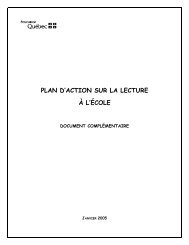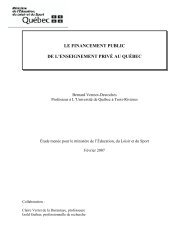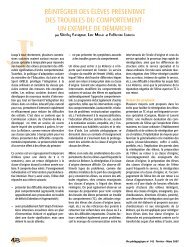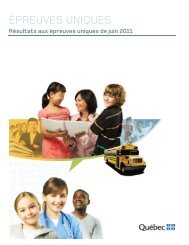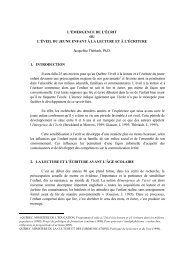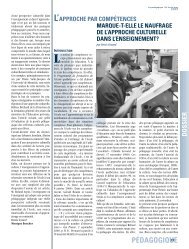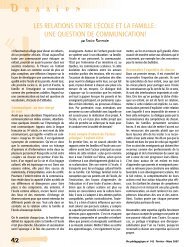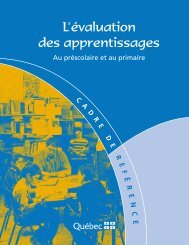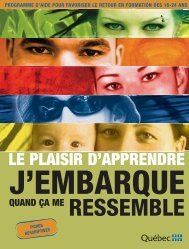Programme de formation de l'école québécoise - Ministère de l ...
Programme de formation de l'école québécoise - Ministère de l ...
Programme de formation de l'école québécoise - Ministère de l ...
Create successful ePaper yourself
Turn your PDF publications into a flip-book with our unique Google optimized e-Paper software.
COMPETENCY 1 • TO I N T E R AC T O R A L LY I N E N G L I S H<br />
Focus of the Competency<br />
ME A N I N G O F T H E CO M P E T E N C Y<br />
Right from the beginning in Elementary 3, s t u d e n t s<br />
express themselves in English in any given classroom situation<br />
(classroom life, themes explored, carrying out<br />
t a s k s, stu<strong>de</strong>nts’ own interests). They are immersed in<br />
the dynamics of oral interaction (transmission ↔<br />
reception ↔ action ↔ reaction) and have numerous<br />
opportunities to practise as it greatly influences the<br />
<strong>de</strong>gree to which they can speak English. As they <strong>de</strong>velop<br />
the competency, stu<strong>de</strong>nts spontaneously use functional<br />
l a n g u a g e, compensatory and learning strategies, a n d<br />
visual and linguistic resources. Resources help expand<br />
the range of exposure to new language. In a rich and<br />
stimulating linguistic environment, stu<strong>de</strong>nts do not have<br />
to rely on memory alone; effective use of visual support<br />
helps learners <strong>de</strong>velop confi<strong>de</strong>nce and autonomy, and it<br />
accelerates learning of authentic language. In or<strong>de</strong>r to<br />
maintain the use of English during class time, s t u d e n t s<br />
benefit from frequent and spontaneous input from the<br />
teacher as a mo<strong>de</strong>l and facilitator, the help of their peers,<br />
the <strong>de</strong>velopment of positive attitu<strong>de</strong>s and a rich linguistic<br />
environment.<br />
Domaine <strong>de</strong>s langues<br />
CO N N E C T I O N S TO CR O S S- CU R R I C U L A R CO M P E T E N C I E S<br />
The very nature of oral interaction puts stu<strong>de</strong>nts to work<br />
with others. Therefore in or<strong>de</strong>r to build the necessary<br />
cooperative and social skills, stu<strong>de</strong>nts draw upon the<br />
cross-curricular competency To cooperate. A l s o, for interaction<br />
to occur effectively, stu<strong>de</strong>nts need to learn how to<br />
communicate with a certain <strong>de</strong>gree of accuracy thus contributing<br />
to the <strong>de</strong>velopment of the cross-curricular competency<br />
To communicate appropriately.<br />
CO N T E X T S F O R LE A R N I N G<br />
The learning contexts for this competency require:<br />
– opportunities to interact with peers and the teacher, i n<br />
English only, from day one<br />
– numerous occasions to practise and experiment with<br />
functional language<br />
– opportunities to <strong>de</strong>velop compensatory and learning<br />
strategies through use<br />
– help from the teacher and peers<br />
– access to abundant visual support (posters, word and<br />
expression banks, c h e c k l i s t s, e t c . )<br />
– a vailability of linguistic resources (texts, visual and thematic<br />
dictionaries, Internet sites, e t c . )<br />
– opportunities to take risks as a learner<br />
English as a Second Language 354<br />
DE V E L O P M E N TA L PR O F I L E<br />
To <strong>de</strong>velop the competency, stu<strong>de</strong>nts react to messages<br />
using strategies, t a ke the initiative to transmit oral messages<br />
using strategies and maintain oral interaction<br />
using strategies. When they react to messages, s t u d e n t s<br />
listen attentively, accept not being able to un<strong>de</strong>rstand<br />
e v e r y t h i n g , t a ke into account the nonverbal cues of the<br />
person speaking, and use pertinent nonverbal or verbal<br />
r e a c t i o n s. When they take the initiative to transmit oral<br />
messages in relevant situations, stu<strong>de</strong>nts may ask for<br />
h e l p, request permission, express courtesy, a g r e e m e n t ,<br />
n e e d s, feelings and interests, as well as share personal<br />
experiences and research results. When they maintain<br />
oral interaction, stu<strong>de</strong>nts keep the interaction going over<br />
a period of time. I n i t i a l l y, stu<strong>de</strong>nts mostly imitate mo<strong>de</strong>ls<br />
of interaction and re-use functional language and strategies<br />
in appropriate situations; these exchanges are short<br />
in duration.As stu<strong>de</strong>nts progress through the cycles, t h e y<br />
broa<strong>de</strong>n their knowledge of the language and their<br />
repertoire of strategies, and they participate more actively<br />
and effectively in all kinds of interactive classroom situ<br />
a t i o n s. They take more risks when expressing thems<br />
e l v e s, manage the resources at their disposal more<br />
autonomously and find creative ways to employ functional<br />
language to produce personalized messages.




